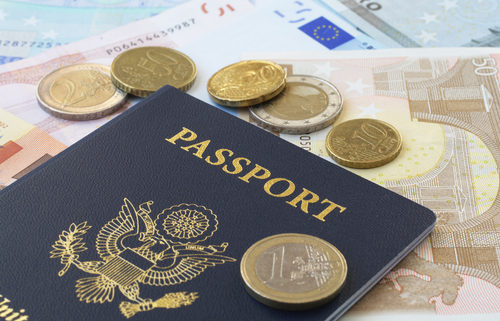How Much Money Should You Bring on Your Next Vacation?
You know as a general rule of thumb that you should have cash on you when you’re traveling—but just how much is enough?
Budgeting for a vacation is equally as important as researching restaurants and putting together an agenda before jet setting to a new destination. Some people make the mistake of only budgeting for the pre-set costs like flights and room bookings. You need to consider how much cash is necessary for when you reach your destination, too. Here’s how travel experts figure out how much money to take on vacation—and how much you should always bring.

Start with all the expenses you know
Before you can determine how much cash to bring on a trip, you need to see the whole financial picture. So start by listing all prepaid expenses, suggests Cassandra Brooklyn, the head of travel planning company EscapingNY. This includes your hotel, flight, and any excursions you prepay. Then, estimate and list out remaining expenses like meals, gratuities, museum admissions, and souvenirs to get an idea of how much to bring. Prioritizing this list is one of the 9 secrets to traveling cheap, according to travel agents.
Next, see what on this list you might also be able to prepay, recommend Angela Rice, the co-founder of Boutique Travel Advisors. “Prepaying for as much as possible for such items as transfers, tours, and meals will reduce cash flow needs during the time of travel and help to keep you on a planned travel budget,” Rice says. Many guided tours and cruises offer travelers the option to even prepay gratuities.
Consider your credit card options
The amount of money you bring also depends on if you can use a credit or debit card. For international travelers, some countries like Iceland are more card-friendly than others, like Mexico, according to Brooklyn. The level of cash necessary for your trip in any specific country or region really depends on the acceptance of credit cards, debit cards, and other forms of payment, says Rice. Not all shops and restaurants accept bank cards, especially in less-developed nations. Although, you still might be able to utilize some travel credit card perks on vacation.
Plus, there are rules and fees for different types of cards. Confirm whether or not you can use your specific credit card abroad and if there are any foreign transaction fees. Note that American Express is less widely accepted abroad, so if it’s the only credit card you own you’ll likely need to bring more cash, says Brooklyn.
If you’re going abroad, don’t forget about exchanging currency
One of the most annoying parts of traveling abroad is worrying about currency exchanges. That’s why Rice recommends acquiring the local currency for where you are visiting before your departure. “While travelers may have good intentions of obtaining local currency upon arrival, this doesn’t typically happen and often creates unnecessary stress,” says Rice. “People are too exhausted and ready to settle into their hotel after a long day of travel to immediately go searching for a bank with a favorable exchange rate.” This hunt for cash is one of the little travel mistakes that make your vacation unnecessarily stressful.
If you are willing to do a little leg work and do want to exchange currency at your destination, figure out just how challenging it will be to exchange money. “Rural areas and countries that receive tourists tend to have fewer opportunities to exchange money, so it’s best to exchange sufficient money before leaving the airport or major city,” says Brooklyn. The more of a hassle it is to find a money exchange or a bank, the better off you’ll be if you exchange more money upfront. Otherwise, if it is easy to exchange money where you travel, Brooklyn recommends exchanging smaller amounts during the trip to avoid exchanging too much and then losing money when you have to exchange it back.
Here’s the average amount of money you should bring on vacation
Brooklyn always brings a few hundred dollars of your own country’s money, no matter where she travels. She recommends bringing crisp, new, $100 bills which receive the best exchange rate since some countries have different rates depending on how large and new the bills are. Plus, these bills take up less space, are easy to hide, and you can bring them back home if you don’t use them.
Rice says that a reasonable baseline is between $50 to $100 per day per traveler. Again, this is just an average. The amount of money already accounted for your trip, plus where you are going are the two biggest factors that make or break how much money you’ll really need. “Goods and services are costly in countries like Iceland, Switzerland, and Norway, whereas other popular destinations such as Indonesia, Thailand, and Turkey are more affordable,” says Rice. “Yet, people tend to shop more in the latter countries, so what you intend to purchase is also a factor.” So if you are traveling to locations with a high cost of living and haven’t prepaid for many things, you’ll need more cash than say someone going on one of the best all-inclusive vacations.
Despite being accepted in 27 different countries, rice says the U.S. dollar isn’t as popular with other countries as you might think. Ideally, travelers should anticipate using the local currency. You don’t want to be without cash for a quick pint in Ireland, a scoop of gelato while on the go in Rome, or when you need to tip a service worker. So budget ahead of time and keep your cash safe. Spread your money in case of an emergency. Brooklyn recommends keeping some in a wallet, pocket, carry-on luggage, your day pack, and the hotel safe, too.
Keep your cash safe with these tips
Money belts and fanny packs, like this one, are great for keeping important items close and safe, but Brooklyn also warns that you want to avoid a false sense of security. “Letting your guard down while having all your belongings in one place can make a potential theft more devastating,” says Brooklyn. To keep your stuff safe, Brooklyn recommends keeping your wallet and money in front pockets, wearing your backpack backward, and wearing a purse across your shoulder and neck to make your belongings harder to steal. Rice also suggests not opening your wallet or purse in public as much as possible.
Let your bank know of travel plans in advance and set daily limits on your credit card or request the bank to confirm purchases as an extra layer of financial protection. Forgetting to do this is one mistake you might make before you even get the chance to fall for these 10 other sneaky money traps people fall for every time they travel.
Source: https://www.rd.com/advice/travel/how-much-money-should-you-bring-on-vacation/



